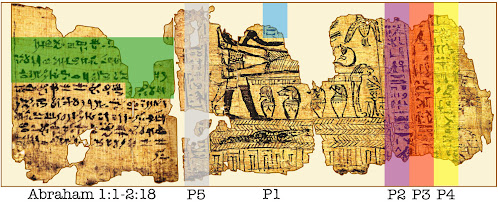Previously on the board I wrote extensively on the Mormon-Masonic connection. In addition, I promised at some time to share some of my research on the Masonic roots of the Book of Abraham. Sadly, other important tasks have largely superseded and I have never gotten a chance to post the information or get it published. If you guys are amenable, I would love to share some of the research here on this thread.
On June 30th, 1835 a traveling exhibitor of Egyptian artifacts began showing his "museum" pieces in Kirtland, Ohio. One of the documents he showed was the Hor Book of Breathings owned originally by the ancient Egyptian Hor. When Joseph Smith examined the document he declared that the document was actually an ancient book of scripture written by the ancient patriarch Abraham. The initial erroneous attribution of the Hor Book of Breathings as having been written by Abraham most likely was made when Joseph Smith looked at the two drawings on the papyrus, one at the beginning of the document, and another at the end of the document. Joseph Smith would later interpret the final drawing as depicting Abraham in the court of Pharaoh expounding on the principles of Astronomy. However, it is Joseph Smith's intriguing interpretation of the first drawing that is, at least from a Masonic perspective, even more intriguing.

When Joseph Smith first saw the drawing at the beginning of the scroll he would have seen an already damaged (similar to it's present day form) scene in which a man is reclining on a "lion couch". Strangely, Joseph Smith interpreted this scene as the sacrifice of Abraham by a priest of Pharaoh. What is strange about this interpretation is that should Joseph Smith have been drawing from the Bible, a more available comparison would have been to attribute the executor as Abraham and the to be executed as Isaac. So why did Joseph suggest an assassination attempt on Abraham.
The key to understanding Joseph Smith's interpretation of this scene, and in fact the whole of the content and translation process is found in a Masonic book circulating in the New York area in the early 1820s entitled Antiquities of Freemasonry. This book tells how "[Abraham] [h]aving student Masonry under Shem with unabated diligence and assiduity, until he was perfect master of the art, he communicated with a select few of his own family, who retained some indistinct remembrance of Masonry, though much adulterated and obscured by innovations[.]" This story is similar to what Joseph Smith would translate including the idea that he was "successful in his own family" but that his "exertions to restore the true principles of Masonry" were "replete with danger" leading the "vengence of the Chaldeans" which "openly threatened [Abraham] with destruction." This led the authorities to take action making sure "[the king] overwhelmed the patriarch with every species of persecution, and condemned him to perish by fire." (Antiquities of Freemasonry, 149-150)
Thus Masonic literature in Joseph Smith's day suggested that Abraham had been exposed to Masonic priesthood authority, that he exerted influence to convert his family and close associates back to a belief in Masonic priesthood, and as a results he had raised the ire of the authorities. This assault on the local priesthood then, in turn, led to "every species of persecution". It is my thesis, that Joseph Smith was drawing from Antiquities of Freemasonry for content to reconstruct the Biblical record and to translate what he thought was the a manuscript written by Abraham which had appeared in Kirtland by divine providence.
In a subsequent post, I will examine Joseph Smith's translation of a portion of the five columns of vertical text surrounding this diagram using the Antiquities of Freemasonry as source material.